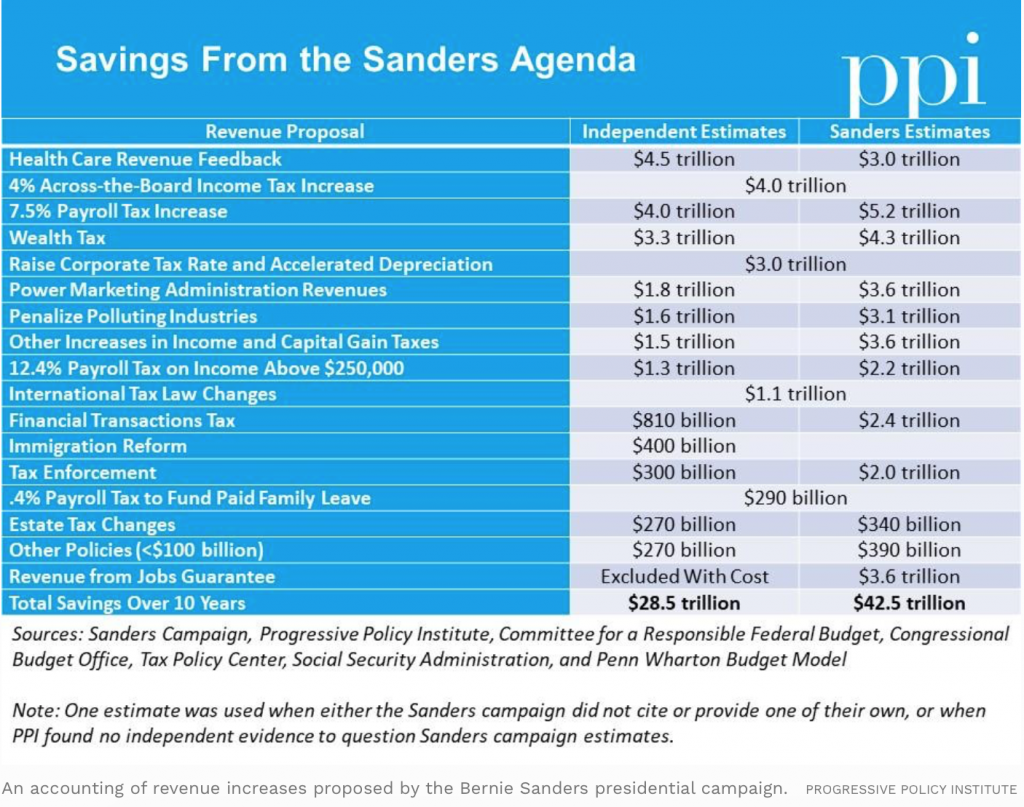This week, Ben Ritz, a brilliant young public finance mind and the Director of the Progressive Policy Institute, published a phenomenal article on Forbes Magazine accounting the costs of Senator Sanders’s social programs. In his calculation, Ritz dug into the information the Senator released after a very confusing interview with Anderson Cooper, where his vague responses questioned the fiscal viability of the proposals that are the core of his presidential campaign.
Ben Ritz, whose charts we hereby reproduce, concludes that Senator Sanders’s proposals will create a “$25 Trillion Fiscal Hole.” This makes Sanders’s plans not only fiscally inviable but, more importantly, politically impossible, if you think about the massive legislative efforts that he would need to pass in both the House and the Senate.
Does this mean that we have to abandon the goals of Medicare for All, Affordable College, Universal Pre-K and childcare programs, as well as appropriate funding to public schools, and many other economic equities and social justice ideals? NO. What we need to do is set the goals and make progress in a politically, economically, and fiscally viable way.

Take healthcare, for example. You can achieve the goal of universal, affordable care by adding the public option to the current ACA (Obamacare) system, strengthening the ACA, finetuning certain subsidies, and moving across the country with a big push for Medicaid expansion (like it has happened in 37 states and DC). This solution will let the American people choose between their current insurance and the public option, which over the years will eventually lead us to a viable universal healthcare care system shaped by the citizens’ decision. Yet, Senator Sanders has a point when he says that there is much more to do (particularly in bringing prescription drug costs down to international prices), and saving tons of money in administration costs. There, regulations, opening to imports to create competition in the pharmaceutical market, and other incentives can play a significant role. Indeed, the United States is investing more than 19% of GDP in healthcare, compared to an average of 12% of GDP spent by other developed nations that have universal healthcare like Germany, Spain, or Canada; and American citizens are far less covered than our counterparts in the developed world.
The same can be said about college and higher education affordability. Instead of a fiscally-funded/tuition-free education for all in every public university, we can achieve much more (in a viable way) if we take the path of working on tuition-free education for the first two years in Community Colleges. Additionally, invest in a strong diversification of higher education alternatives with workforce development programs (matching funds with the states when possible), including appropriate funding for need-based grants, civil service repayment or debt cancellation programs, among other ideas.
One has to think and work with the “realpolitik” if you want to be a progressive that gets things done while ensuring economic and employment growth. The bottom line is that an ambitious agenda—as proposed by Senator Sanders—is a political gamble and has no viability unless you can imagine sweeping legislative reforms and budgetary changes. Moreover, the only tax that would make it fiscally fundable (together with the massive reforms needed) is adding to our tax system a federal Value Added Tax (VAT). That is the case in Europe and other developed nations, with strong and universal social programs in healthcare and education. If such an endeavor seems far from possible, as a progressive, I rather walk the path of viable gradual changes as those highlighted in this note.

